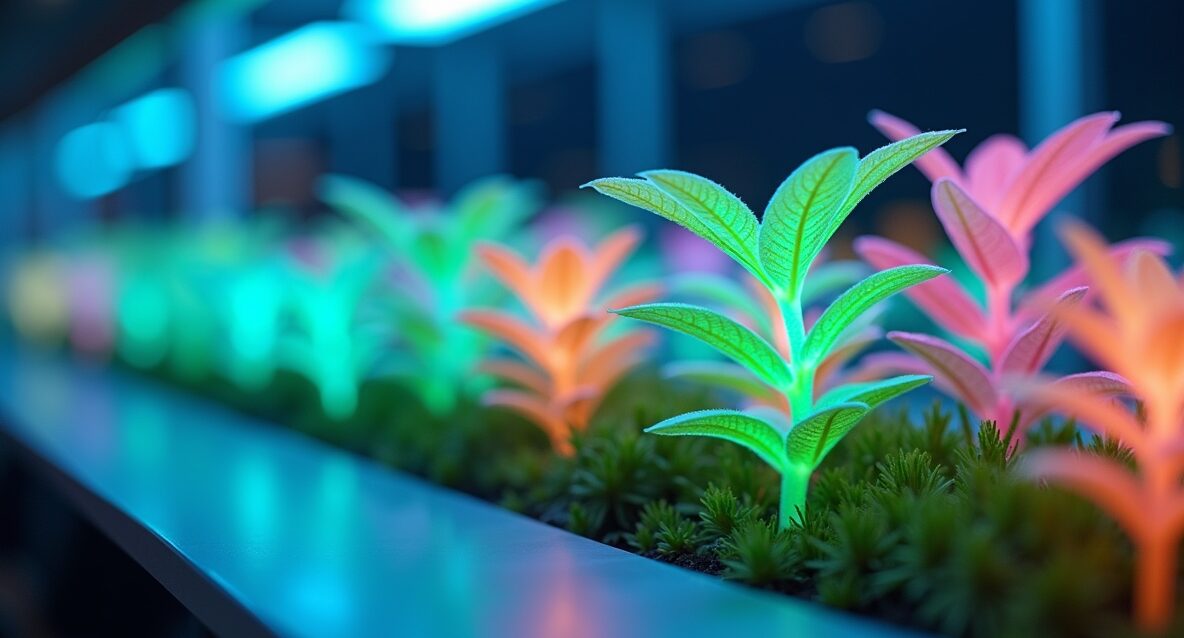Have you ever wandered through a quaint village market and marvelled at the vibrant rows of fresh produce—carrots with their leaves still glistening, tomatoes redder than a sunrise? I once did that in a small town just outside Cambridge. There was this organic farm stand brimming with heirloom vegetables, so colourful they looked straight out of an artist’s palette. I couldn’t help but imagine a future where each plant is not just grown but programmed—tailored from its genetic code upwards to meet our evolving needs. It was magic.
The Rise of Programmable Plants
Now, you might be thinking, “Programmable plants? That sounds like something straight out of a sci-fi novel.” Trust me, I used to think the same—until I delved deeper into the latest research on heritable agriculture. Heritable agriculture means altering the genetic makeup of plants in ways that can be passed down through generations, thus embedding specific traits and functionalities.
I recall a conversation with a botanist friend who described it like adjusting the knobs on a mixing console. Each gene is a separate control, and by tweaking them—turning some up, dialling others down—you can orchestrate entirely new plant behaviours. If you’re worried about lab-coat-wearing scientists playing God, that’s understandable… but let’s explore why this is more about stewardship than it is about hubris.
It’s also worth noting that current events have pushed this topic into the spotlight. With climate change accelerating and populations growing fast, our farming systems are under immense pressure. We need more robust crops that can withstand extreme weather, pests, and diseases. Programmable plants can offer a lifeline—resistant to floods in one region, tolerant of drought in another—adapting as swiftly as the environment demands.
Emerging Tools and Techniques
To make plants “programmable,” researchers are leveraging cutting-edge methods like CRISPR gene editing and machine learning algorithms. CRISPR, if you’re not familiar, is basically a microscopic pair of scissors that can cut and paste sections of DNA, allowing for precise reprogramming. Meanwhile, machine learning helps to predict which genetic modifications will yield the most beneficial traits.
I’ve personally tinkered with machine learning models at a hackathon—though on a far less complex project. It gave me a glimpse of the potential. The software could comb through volumes of data in mere seconds, which would’ve taken a human researcher years to decode. According to a niche industry report from Hugging Face’s 2024 LLM Adoption Survey, more laboratories are turning to large language models to accelerate biotech discoveries. It’s fascinating, and honestly, a bit dizzying.
But let’s be clear: this isn’t a magic wand that solves all problems overnight. Genetic engineering can be slow and expensive. Plus, there are ethical and ecological concerns—such as the risk of altered plants outcompeting native species or transferring genes to wild relatives. Scientists are aware of these pitfalls, and many are working on containment strategies, like designing genetic “switches” that only activate under specific conditions. Imagine a built-in safety net, similar to having a seatbelt in a car: it’s there to protect both us and the environment if things go awry.
Why This Matters
You might be asking, “So why should I care?” Well, the reasons are multiple—and heartfelt. I’m not a fan of doomsday scenarios, but let’s face it: we’re dealing with erratic weather patterns, declining soil fertility, and a global population that’s hungry for more nutritious food. We can’t keep farming the way we did decades ago and expect the land to keep giving.
Heritable agriculture could mean more equitable food distribution. Imagine entire villages in drought-prone areas growing staple crops that hardly need irrigation. Farmers worldwide could benefit from seeds already ‘programmed’ to resist emerging pests. It’s like having a travel adapter in your suitcase: no matter where you go, your device (in this case, your crop) is ready to plug into the local conditions.
But I do feel a twinge of concern about corporate control. Big agritech companies might over-patent these genetic modifications, leaving small farmers dependent on pricey seed subscriptions. We’ve seen something similar in the software industry, where subscription models can lock out smaller players. It’s crucial to balance innovation with fair access.
Wrapping Up: Our Collective Role
If there’s one thing I’ve learned, it’s that progress can’t be stopped. Genetic research is leaping forward whether we like it or not. Yet, it’s up to us—researchers, policymakers, and everyday folks—to steer that progress responsibly. We should champion open-source approaches, support transparent regulations, and encourage public dialogue. Talking about heritable agriculture doesn’t have to be fraught with fear; it can be a platform for collective brainstorming, ethical checks, and real-world solutions.
In the end, making plants programmable isn’t about creating monstrous, lab-grown Frankenfoods. It’s more like teaching an old friend a new skill—like you would with a relative who’s just picked up a smartphone for the first time. The aim is to help plants and people thrive together in a world that’s evolving faster than ever.
I truly believe we’re on the cusp of a transformation—one where fields become data-driven ecosystems, and your backyard tomato plant might have genetics expertly tuned for maximum flavour and resilience. That’s the promise and peril of this brave new frontier in agriculture. And while we can’t predict every outcome, we can remain curious, cautious, and hopeful… all at once.
Conclusion
Heritable agriculture stands as a compelling vision for the future. It offers a glimpse of how our food systems might adapt to the challenges of a changing planet. Of course, questions remain—ethical, ecological, and economic. But like the first time I saw those brilliantly coloured vegetables at that roadside stall, I can’t help but marvel at what’s possible when human ingenuity and nature’s blueprint come together. We’ve got the chance to nurture a world where each seed is a story of resilience, written into its very DNA. Let’s embrace it, thoughtfully.




